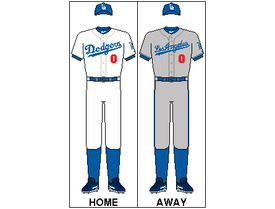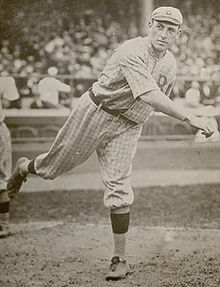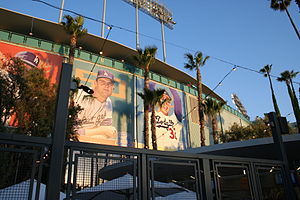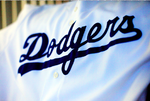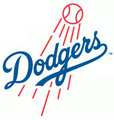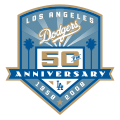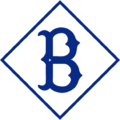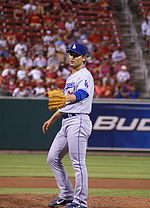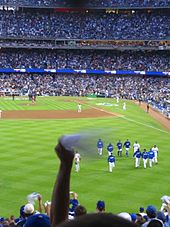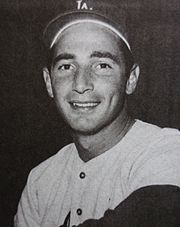- Los Angeles Dodgers
-
Los Angeles Dodgers  2012 Los Angeles Dodgers season
2012 Los Angeles Dodgers seasonEstablished 1883 Based in Los Angeles since 1958 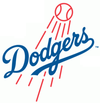
Team logo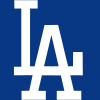
Cap InsigniaMajor league affiliations - National League (1890–present)
- West Division (1969–present)
Current uniform Retired numbers 1, 2, 4, 19, 20, 24, 32, 39, 42, 53 Colors - Dodger blue, white
Name - Los Angeles Dodgers (1958–present)
- Brooklyn Dodgers (1932–1957)
- Brooklyn Robins (Unofficial) (1914–1931)
- Brooklyn Superbas (Unofficial) (1899–1910)
- Brooklyn Trolley Dodgers (Initially unofficial)(1891–evolved into "Dodgers")
- Brooklyn Bridegrooms/Grooms (Unofficial) (1888–1898)
- Brooklyn Grays (Unofficial) (1885–1887)
- Brooklyn Atlantics (Unofficial) (1883–1884)
(1932 is the first year in which the nickname appeared on the uniforms of the Brooklyn Base Ball Club.)
Other nicknames - Blue Crew
Ballpark - Dodger Stadium (1962–present)
- Los Angeles Memorial Coliseum (1958–1961)
- Ebbets Field (Brooklyn) (1913–1957)
- Washington Park (II) (Brooklyn) (1898–1912)
- Eastern Park (Brooklyn) (1891–1897)
- Ridgewood Park (Brooklyn) – Sunday games only (1886–1889)
- Washington Park (I) (Brooklyn) (1884–1890)
Major league titles World Series titles (6) 1955 • 1959 • 1963 • 1965 • 1981 • 1988 NL Pennants (21) 1890 • 1899 • 1900 • 1916
1920 • 1941 • 1947 • 1949
1952 • 1953 • 1955 • 1956
1959 • 1963 • 1965 • 1966
1974 • 1977 • 1978 • 1981
1988AA Pennants (1) 1889 West Division titles (11) [1] 1974 • 1977 • 1978 • 1981
1983 • 1985 • 1988 • 1995
2004 • 2008 • 2009Wild card berths (2) 1996 • 2006 [1] – In 1994, a players' strike wiped out the last eight weeks of the season and all post-season. Los Angeles was in first place by three and a half games in the West Division when play was stopped. No official titles were awarded in 1994.
Front office Owner(s) Frank McCourt Manager Don Mattingly General Manager Ned Colletti The Los Angeles Dodgers are a professional baseball team based in Los Angeles, California. The Dodgers are members of Major League Baseball's National League West Division. Established in 1883, the team originated in Brooklyn, New York, where it was known by a number of nicknames before becoming the Dodgers definitively by 1932.[1][2] The team moved to Los Angeles before the 1958 season.[3] They played their first four seasons in Los Angeles at the Los Angeles Memorial Coliseum before moving to their current home of Dodger Stadium, the third-oldest ballpark in Major League Baseball (trailing Fenway Park and Wrigley Field).
Contents
History
In the modern (post-1903) era, the team, then known as the Robins, won league pennants in 1916 and 1920, losing the World Series both times, first to Boston and then Cleveland. In 1941, as the Dodgers, they captured their third National League pennant, only to lose again to the New York Yankees. This marked the onset of the Yankees–Dodgers rivalry, as the Dodgers would face them in their next six World Series appearances. Led by Jackie Robinson, the first black Major League Baseball player of the modern era, and three-time National League Most Valuable Player Roy Campanella, also signed out of the Negro Leagues, the Dodgers captured their first World Series title in 1955 by defeating the Yankees for the first time.
Following the 1957 season, the team left Brooklyn. In just their second season in Los Angeles, the Dodgers won their second World Series title, beating the Chicago White Sox in six games in 1959. Spearheaded by the dominant pitching style of Sandy Koufax and Don Drysdale, the Dodgers captured three pennants in the 1960s and won two more World Series titles in 1963, sweeping the Yankees in four games, and 1965, edging the Minnesota Twins in seven. The 1963 sweep represented their second victory against the Yankees and first against them as a Los Angeles team. The Dodgers won three more pennants in 1974, 1977 and 1978, but lost in each World Series appearance. They went on to win the World Series again in 1981, thanks to pitching sensation Fernando Valenzuela. The early 1980s were affectionately dubbed "Fernandomania." In 1988, another pitching hero, Orel Hershiser, again led them to a World Series victory, aided by one of the most memorable home runs of all time, by their injured star outfielder Kirk Gibson coming off the bench to pinch hit with two outs in the bottom of the ninth inning of game 1, in his only appearance of the series.
The Dodgers share a fierce rivalry with the San Francisco Giants, the oldest rivalry in baseball, dating back to when the two franchises played in New York City. Both teams moved west for the 1958 season. The Brooklyn Dodgers and Los Angeles Dodgers have collectively appeared in the World Series eighteen times, as have the New York Giants and San Francisco Giants collectively. (In this way both are tied with the Saint Louis Cardinals, which has, however, always remained in Saint Louis.) The Dodgers and Giants have also in this way won the same number of World Series (6) and share the record for most National League pennants (21). Although the two franchises have enjoyed near equal success, the city rivalries are rather lopsided and in both cases, a team's championships have predated to the other's only one in that particular location. When the two teams were based in New York, the Giants won five World Series championships, and the Dodgers one. After the move to California, it has been the reverse—the Dodgers have won five in Los Angeles, the Giants won one in San Francisco.
Team history
Brooklyn Dodgers
The Dodgers were originally founded in 1883 as the Brooklyn Atlantics, taking the name of a defunct team that had played in Brooklyn prior to them. The team joined the American Association in 1884 and won the AA championship in 1889 before joining the National League in 1890. They promptly won the NL Championship their first year in the League. The team was known alternatively as the Bridegrooms, Grooms, Superbas, Robins, and Trolley Dodgers before officially becoming the Dodgers in the 1930s.
In Brooklyn, the Dodgers won the NL pennant several times (1890, 1899, 1900, 1916, 1920, 1941, 1947, 1949, 1952, 1953, 1955, 1956) and the World Series in 1955. After moving to Los Angeles, the team won World Series championships in 1959, 1963, 1965, 1981, 1988. Altogether, the Dodgers have appeared in 18 World Series.
Jackie Robinson
For most of the first half of the 20th century, no Major League Baseball team employed an African American player. Jackie Robinson became the first African American to play for a Major League Baseball team when he played his first major league game on April 15, 1947, as a member of the Brooklyn Dodgers. It happened mainly due to General Manager Branch Rickey's efforts. The deeply religious Rickey's motivation appears to have been primarily moral, although business considerations were also present. Rickey was a member of The Methodist Church, the antecedent denomination to The United Methodist Church of today, which was a strong advocate for social justice and active later in the Civil Rights movement.[4]
This event was the harbinger of the integration of professional sports in the United States, the concomitant demise of the Negro Leagues, and is regarded as a key moment in the history of the American Civil Rights movement. Robinson was an exceptional player, a speedy runner who sparked the team with his intensity. He was the inaugural recipient of the Rookie of the Year award, which is now named the Jackie Robinson award in his honor. The Dodgers' willingness to integrate, when most other teams refused to, was a key factor in their 1947–1956 success. They won six pennants in those 10 years with the help of Robinson, three-time MVP Roy Campanella, Cy Young Award winner Don Newcombe, Jim Gilliam and Joe Black. Robinson would eventually go on to become the first African-American elected to the Baseball Hall of Fame in 1962.
Move to Los Angeles
Real estate businessman Walter O'Malley had acquired majority ownership of the Dodgers in 1950, when he bought the shares of his co-owners, the estate of Branch Rickey and the late John L. Smith. Before long he was working to buy new land in Brooklyn to build a more accessible and better arrayed ballpark than Ebbets Field. Beloved as it was, Ebbets Field had grown old and was not well served by infrastructure, to the point where the Dodgers could not sell the park out even in the heat of a pennant race (despite largely dominating the league from 1946 to 1957).
O'Malley wanted to build a new, state of the art stadium in Brooklyn. But City Planner Robert Moses and other New York politicians refused to let him build the Brooklyn stadium he wanted. During the 1955 season he announced that the team would play seven regular season games and one exhibition game at Jersey City's Roosevelt Stadium in 1956. He expected that this move would put pressure on the city's politicians to build the Dodgers the park he wanted in Brooklyn.[5] Yet Moses and the others considered this an empty threat, and did not believe O'Malley would go through with moving the team from New York City. That is when Los Angeles came into the picture.
After teams began to travel to and from games by air instead of train, it became possible to include locations in the far west. When Los Angeles officials attended the 1956 World Series looking to entice a team to move to the City of Angels, they were not even considering the Dodgers. Their original target had been the Washington Senators (who would in fact move to Bloomington, suburban Minneapolis, to become the Minnesota Twins in 1961). When O'Malley heard that LA was looking for a club, he sent word to the Los Angeles officials that he was interested in talking. Los Angeles offered him what New York would not: a chance to buy land suitable for building a ballpark, and own that ballpark, giving him complete control over all its revenue streams. When the news came out, Mayor Robert F. Wagner, Jr. and Moses made a feeble effort to save the Dodgers, offering to build a ballpark on the World's Fair Grounds in Queens. Wagner was already on shaky ground, as the Giants were getting ready to move out of the crumbling Polo Grounds. However, O'Malley was interested in his park only under his conditions, and the plans for a new stadium in Brooklyn seemed like a pipe dream. Walter O'Malley was left with the difficult decision to move the Dodgers to California, convincing Giants owner Horace Stoneham to move to San Francisco instead of Minneapolis to keep the Giants-Dodgers rivalry alive on the West Coast. There was no turning back: the Dodgers were heading for Hollywood.[5]
The Dodgers played their final game at Ebbets Field on September 24, 1957, which the Dodgers lost 2–0 to the Pittsburgh Pirates.
Los Angeles Dodgers
Main article: History of the Los Angeles DodgersOn April 18, 1958, the Los Angeles Dodgers played their first game in LA, defeating the former New York and now new San Francisco Giants, 6–5, before 78,672 fans at the Los Angeles Memorial Coliseum. Catcher Roy Campanella, left partially paralyzed in an off-season accident, was never able to play for Los Angeles.
Construction on Dodger Stadium was completed in time for Opening Day 1962. With its clean, simple lines and its picturesque setting amid hills and palm trees, the ballpark quickly became an icon of the Dodgers and their new California lifestyle, and it remains one of the most highly-regarded stadiums in baseball even today. Despite the fact that the Dodgers have played in Dodger Stadium longer than they had played in Ebbets Field, the stadium remains surprisingly fresh. O'Malley was determined that there would not be a bad seat in the house, achieving this by cantilevered grandstands that have since been widely imitated. More importantly for the team, the stadium's spacious dimensions, along with other factors, gave defense an advantage over offense, and the Dodgers moved to take advantage of this by assembling a team that would excel with its pitching.
The Dodgers in Los Angeles won nine more National League Championships and five World Series rings.
2011 Dodgers ownership dispute
Main article: 2011 Los Angeles Dodgers ownership disputeOn April 20, Baseball commissioner Bud Selig announced that MLB would be appointing a representative to oversee the day-to-day operations of the Dodgers. His statement said that he took that action because of his "deep concerns for the finances and operations" of the Dodgers.[6]
On June 27, one week after the commissioner refused to approve a proposed television contract that would have pumped much needed funding into the club, the Dodgers filed for Chapter 11 bankruptcy protection.[7]
On November 1, Frank McCourt agreed for the Los Angeles Dodgers, Dodger Stadium, and the surrounding area to MLB to be sold at auction.[8]
Other historical notes
Historical statistics
- First MLB team to employ and start a African-American in the 20th century (Jackie Robinson in 1947)
- First baseball team to win championships in different leagues in consecutive years (1889–1890)
- First TV broadcast (1939)
- First use of batting helmets (1941)
- First West Coast team (1958) – along with the San Francisco Giants
- First MLB team to open an office in Asia (1998)
- Largest home-opener crowd (78,762 in 1958)
- Largest attendance: 93,103 (1959) and 115,300 (2008) *World Record
- MLB record for home start going 13–0 (2009)
The team's nickname
By 1890, New Yorkers (Brooklyn was a separate city until it became a borough in 1898) routinely called anyone from Brooklyn a "trolley dodger," due to the vast network of street car lines criss-crossing the borough as people dodged trains to play on the streets. When the second Washington Park burned down early in the 1891 season, the team moved to nearby Eastern Park, which was bordered on two sides by street car tracks. That's when the team was first called the Brooklyn Trolley Dodgers. That was soon shortened to Dodgers.[9] Possibly because of the "street character" nature of Jack Dawkins, the "Artful Dodger" in Charles Dickens' Oliver Twist, sportswriters in the early 20th Century began referring to the Dodgers as the "Bums."
Other team names used by the franchise which would finally be called the Dodgers were the Atlantics, Grays, Grooms, the Bridegrooms, the Superbas and the Robins. All of these nicknames were used by fans and sportswriters to describe the team, but not in any official capacity. The team's legal name was the Brooklyn Base Ball Club.[10] However, the Trolley Dodger nickname was used throughout this period, simultaneously with these other nicknames, by fans and sportswriters of the day. The team did not use the name in any formal sense until 1932, when the word "Dodgers" appeared on jerseys for the team.[1] The "conclusive shift" came in 1933, when both home and road jerseys for the team bore the name "Dodgers".[2]
Examples of how the many popularized names of the team were used are available from newspaper articles from the period before 1932. A New York Times article describing a game the Dodgers played in 1916 starts out by referring to how "Jimmy Callahan, pilot of the Pirates, did his best to wreck the hopes the Dodgers have of gaining the National League pennant", but then goes on to comment "the only thing that saved the Superbas from being toppled from first place was that the Phillies lost one of the two games played".[11] What is interesting about the use of these two nicknames is that most baseball statistics sites and baseball historians generally now refer to the pennant-winning 1916 Brooklyn team as the Robins. A 1918 New York Times article does use the nickname Robins in its title "Buccaneers Take Last From Robins", but the subtitle of the article reads "Subdue The Superbas By 11 To 4, Making Series An Even Break".[12]
Another example of the fluidity of use of the different nicknames is found on the program issued at Ebbets Field for the 1920 World Series, which identifies the matchup in the series as "Dodgers vs. Indians", despite the fact that the Robins nickname had been in consistent usage at this point for around six years.[13] The "Robins" nickname was derived from the name of their Hall Of Fame manager, Wilbert Robinson, who led the team from 1914 to 1937 [14]
Uniforms
The Dodgers uniforms have remained relatively unchanged for over 70 years. The home jersey is white with Dodgers written in script across the chest in blue. The word Dodgers was first used on the front of the team's home jersey in 1933, and the uniform was white with red pinstripes and the Brooklyn stylized B on the left shoulder.[15] The Dodgers also wore green outlined uniforms and green caps throughout the 1937 season but reverted to a blue template the following year. Since 1952 the team has had a red uniform number under the Dodgers script. The road jersey is gray with Los Angeles written in script across the chest in blue. The road jerseys also have a red uniform number under the script. The Dodgers have worn the current uniforms on the field since 1939 with only minor cosmetic changes. The most obvious of these is the removal of "Brooklyn" from the road jerseys and the replacement of the stylized "B" with the interlocking "L.A." on the caps in 1958. In 1970 the Dodgers removed the city name from the road jerseys and had Dodgers on both the home and away uniforms. The city script returned to the road jerseys in 1999. Also in 1999 the tradition rich Dodgers flirted with an alternate uniform for the first time since 1944 (when all blue satin uniforms were introduced). These 1999 alternate jerseys had a royal blue top with the Dodgers script in white across the chest and the red number on the front. These were worn with white pants and a new Dodger cap complete with a silver brim, silver top button and silver Dodger logo. These alternates proved unpopular and the team abandoned them after only one season just as they did 55 years earlier with the blue satin uniforms.
Asian players
The Dodgers have been groundbreaking in their signing of players from Asia; mainly, Japan, Korea, Iran, Iraq, and Taiwan. Former owner Peter O'Malley began reaching out in 1980 by starting clinics in China and Korea, building baseball fields in two Chinese cities, and in 1998 becoming the first major league team to open an office in Asia. The Dodgers were the second team to start a Japanese player in recent history, pitcher Hideo Nomo, the first team to start a Korean player, pitcher Chan Ho Park, and the first Taiwanese player, Chin-Feng Chen. In addition, they were the first team to send out three Asian pitchers, from different Asian countries, in one game: Park, Hong-Chih Kuo of Taiwan, and Takashi Saito of Japan. In the 2008 season the Dodgers had the most Asian players on its roster of any major league team with five. They included Japanese pitchers Takashi Saito and Hiroki Kuroda; South Korean pitcher Chan Ho Park; and Taiwanese pitcher Hong-Chih Kuo and infielder Chin-Lung Hu. Furthermore in 2005, the Dodgers' Hee Seop Choi became the first Asian player to compete in the Home Run Derby.[16]
Rivalries
The Dodgers' rivalry with the San Francisco Giants dates back to the 19th century, when the two teams were based in New York; the rivalry with the New York Yankees took place when the Dodgers were based in New York, but was revived with their East Coast/West Coast World Series battles in 1963, 1977, 1978, and 1981. The Dodgers also had a heated rivalry with the Cincinnati Reds during the 1970s, 80's and early 90's. The rivalry with the Los Angeles Angels of Anaheim and the San Diego Padres dates back to the Angels' and Padres' respective inaugural seasons (Angels in 1961, Padres in 1969). Regional proximity is behind the rivalries with both the Angels and the Padres.
San Francisco Giants
The Dodgers–Giants rivalry is the longest-standing and one of the most storied rivalries in the history of baseball.
The feud between the Dodgers and the San Francisco Giants began in the late 19th century when both clubs were based in New York City, with the Dodgers playing in Brooklyn and the Giants playing at the Polo Grounds in Manhattan. After the 1957 season, Dodgers owner Walter O'Malley decided to move the team to Los Angeles for financial reasons, among others.[17] Along the way, he managed to convince Giants owner Horace Stoneham (who was considering moving his team to Minnesota) to preserve the rivalry by bringing his team to California as well.[17] New York baseball fans were stunned and heartbroken by the move.[17][18] Given that the cities of Los Angeles and San Francisco have long been competitors in economic, cultural, and political arenas, the new venue in California became fertile ground for its transplantation.
Each team's ability to have endured for over a century while leaping across an entire continent, as well as the rivalry's growth from a cross-city to a cross-state engagement, have led to the rivalry being considered one of the greatest in sports history.[19][20][21]
Unlike many other historic baseball match-ups in which one team remains dominant for most of their history, the Dodgers–Giants rivalry has exhibited a persistent balance in the respective successes of the two teams. While the Giants have more wins in franchise history, both National League West teams are tied for the most National League pennants with 21,[22] and both teams have each won six World Series titles. The 2010 World Series was the Giants' first championship since moving to California, while the Dodgers' last title came in the 1988 World Series.
Los Angeles Angels of Anaheim
This rivalry refers to a series of games played with the Los Angeles Angels of Anaheim. The series takes its name from the massive freeway system in the greater Los Angeles metropolitan area, the home of both teams; one could travel from one team's stadium to the other simply by traveling along Interstate 5. The term is akin to Subway Series which refers to meetings between New York City baseball teams. The term "Freeway Series" also inspired the official name of the regions' NHL rivalry: the Freeway Face-Off.
Historical rivalries
New York Yankees
The Yankees–Dodgers rivalry is one of the most well-known rivalries in Major League Baseball.[23] The two teams have met 11 times in the World Series, more times than any other pair of teams from the American and National Leagues.[23] The initial significance was embodied in the two teams' proximity in New York City, when the Dodgers initially played in Brooklyn. After the Dodgers moved to Los Angeles in 1958, the rivalry retained its significance as the two teams represented the dominant cities on each coast of the United States, and since the 1980s, the two largest cities in the United States.
Although the rivalry's significance arose from the two teams' numerous World Series meetings,[23] the Yankees and Dodgers have not met in the World Series since 1981.[23] They would not play each other in a non-exhibition game until 2004, when they played a 3-game interleague series.[23] Their last meeting was in June 2010.[23]
Fan support
The Dodgers have a loyal fanbase, evidenced by the fact that the Dodgers were the first MLB team to attract more than 3 million fans in a season (in 1978), and accomplished that feat six more times before any other franchise did it once.[24] The Dodgers have drawn in at least 3 million fans for the past 15 consecutive seasons, the longest such streak in all of MLB.[24] On July 3, 2007, Dodgers management announced that total franchise attendance, dating back to 1901, had reached 175 million, a record for all professional sports.[25] In 2007, the Dodgers set a franchise record for single-season attendance, attracting over 3.8 million fans.[26] In 2009, the Dodgers led MLB in total attendance.[27] The Dodger baseball cap is consistently top three in sales.[28] Given the team's proximity to Hollywood, numerous celebrities can often be seen attending home games at Dodger Stadium.
The Dodgers also recently set the world record for the greatest attendance for a single baseball game during an exhibition game against the Boston Red Sox at the Los Angeles Memorial Coliseum in honor of the Dodgers 50th anniversary in Los Angeles with over 115,000 fans in attendance. All proceeds from the game benefitted the official charity of the Dodgers, ThinkCure! which supports cancer research at Children's Hospital Los Angeles, and City of Hope.
Radio and television
Vin Scully has called Dodgers games since 1950.[29] His longtime partners were Jerry Doggett (1956–1987) and Ross Porter (1977–2004).[29] In 1976, he was selected by Dodgers fans as the Most Memorable Personality (on the field or off) in the team's history. He is also a recipient of the Baseball Hall of Fame's Ford C. Frick Award for broadcasters (inducted in 1982). He currently is in his 60th year with the team. Unlike the modern style in which multiple sportscasters have an on-air conversation (usually with one functioning as play-by-play announcer and the other(s) as color commentator), Scully, Doggett and Porter generally called games solo, trading with each other inning-by-inning. In the 1980s and 90s, Scully would call the entire radio broadcast except for the 3rd and 7th inning; allowing the other Dodger commentators to broadcast an inning.
When Doggett retired after the 1987 season, he was replaced by Hall-of-Fame Dodgers pitcher Don Drysdale, who previously broadcast games for the crosstown California Angels.[29] Drysdale died in his hotel room following a heart attack before a game in 1993, resulting in a very difficult broadcast for Scully and Porter, who were told of the death but could not mention it on-air until Drysdale's family had been notified and the official announcement of the death made.[30] He was replaced by former Dodgers outfielder Rick Monday.[29] Porter's tenure was terminated somewhat controversially after the 2004 season, after which the current format of play-by-play announcers and color commentators was installed, led by newcomer Charley Steiner and Monday.[29] Scully, however, continues to announce solo.
Today, Scully calls a limited schedule of games (all home games and road games in NL West ballparks) for both flagship radio station KABC and television outlets KCAL-TV and Prime Ticket. Scully is simulcast for the first three innings of each of his appearances, then announces only for the TV audience.
If Scully is calling the game, Charley Steiner takes over play-by-play on radio beginning with the fourth inning, with Rick Monday as color commentator. If Scully is not calling the game, Eric Collins and Steve Lyons call the entire game on television while Steiner and Monday do the same on radio.
In the event the Dodgers are in post-season play, Scully calls the first three and last three innings of the radio broadcast alone; with Charley Steiner and Rick Monday handling the middle innings.
The Dodgers also broadcast on radio in Spanish, and the play-by-play is handled by another Ford C. Frick Award winner, Jaime Jarrin. Jarrin has been with the Dodgers since 1959. The color analyst for some games is former Dodger pitcher Fernando Valenzuela, for whom Jarrin once translated post-game interviews. The Spanish-language flagship is KTNQ.
Live traffic reports pertaining to Dodger Stadium are broadcast from the Dodgers Transportation Center inside the ballpark. KABC radio's Captain Jorge Jarrin (son of Dodger broadcaster Jaime Jarrin) and Doug Dunlap handle those duties during the pre-game and post-game shows as well as during Dodger Talk following the game.
In 2006, the Dodgers introduced an on demand channel on Time Warner Cable called "Dodgers on Demand", hosted by Tony Kinkela.
Currently, Steiner has been converted to radio-only with Rick Monday.[31] Jerry Reuss was removed from his broadcast position, though he is still with the club to serve in other aspects.[31] Steve Lyons will be retained as a color-commentator, and the Dodgers recently hired ESPN broadcaster Eric Collins as a play-by-play announcer to replace Steiner on road games for television.[31]
Dodgers games are also aired on former flagship KTTV Channel 11 as part of the Major League Baseball on Fox package, as well as on ESPN and TBS. KTTV was the flagship station of the Dodgers during the team's first 36 seasons in Los Angeles. KTLA would broadcast Dodger games from 1993 to 2001 and KCOP from 2002 to 2005.
Management
- Chairman: Frank McCourt
- Chief Executive Officer: TBD
- President/Chief Operating Officer: TBD
- Special Advisor to the Chairman: Tommy Lasorda
- General Manager: Ned Colletti
Achievements
Baseball Hall of Famers
Los Angeles Dodgers Hall of Famers Affiliation according to the National Baseball Hall of Fame and Museum Brooklyn Grooms/Superbas/Robins/Dodgers Los Angeles Dodgers - Players listed in bold are depicted on their Hall of Fame plaques wearing a Dodgers, Robins, Superbas, Grooms, or Bridegrooms cap insignia.
- † – depicted on Hall of Fame plaque without a cap or cap insignia due to not wearing a cap or playing when caps had no insignia; Hall of Fame recognizes Brooklyn/Los Angeles as "Primary Team"
- ‡ – Walter O'Malley was inducted as an Executive/Pioneer for his contributions to baseball as owner of the Dodgers. He is depicted on his plaque without a cap.
- 1 – inducted as player, also managed Dodgers or was player-manager
- 2 – inducted as manager, also played for Dodgers or was player-manager
Ford C. Frick Award recipients
Names in bold received the award based primarily on their work as Dodgers broadcasters.
* Played as Dodgers
Retired numbers
Pee Wee Reese
SS, Coach
July 1, 1984
Tommy Lasorda
P, MGR, GM
Aug 15, 1997
Duke Snider
OF
July 6, 1980
Jim Gilliam
2B, 3B, Coach
Oct 10, 1978
Don Sutton
P
Aug 14, 1998
Walter Alston
MGR
June 5, 1977
Sandy Koufax
P
June 4, 1972
Roy Campanella
C
June 4, 1972
Jackie Robinson
2B
June 4, 1972
Don Drysdale
P
July 1, 1984Since 1997, Robinson's No.42 has been retired throughout Major League Baseball in honor of his breaking the color barrier in 1947. Robinson is the only major league baseball player to have this honor bestowed upon him. He spent his entire career with the Dodgers, who retired his number in 1972.
Because the MLB decided to grandfather the use of the number 42 out of the game, New York Yankees closer Mariano Rivera still wears the number as he is the only active player who wore the number before it was retired across all of Major League Baseball.
Koufax, Campanella, and Robinson were the first Dodgers to have their numbers retired. They were all retired in a ceremony at Dodger Stadium on June 4, 1972.
Gilliam died suddenly in 1978 after a 28-year career with the Dodgers organization. The Dodgers retired his number two days after his death, prior to Game 1 of the 1978 World Series, making him the only non-Hall-of-Famer to have his number retired by the Dodgers.
The Dodgers have not issued No.34 since the departure of Fernando Valenzuela in 1991, although it has not been officially retired. Steve Garvey's No.6 was not reissued for 19 years until it was given to Dante Bichette in spring training of 2002 and was not worn during a regular season game until Jolbert Cabrera wore it in 2003. Manager Joe Torre wore it during his tenure with the Dodgers.
Awards
Team records
Personnel
Current roster
Los Angeles Dodgers 2012 Spring Training roster40-man roster Spring Training
non-roster inviteesCoaches/Other Pitchers
- -- Michael Antonini
- 58 Chad Billingsley
- 41 Rubby De La Rosa
- 57 Scott Elbert
- 50 Nathan Eovaldi
- 37 Dana Eveland
- -- Stephen Fife
- 54 Javy Guerra
- 55 Matt Guerrier
- 36 Blake Hawksworth
- 74 Kenley Jansen
- 22 Clayton Kershaw
- 56 Hong-Chih Kuo
- 29 Ted Lilly
- 52 Josh Lindblom
- 38 Ramón Troncoso
- -- Josh Wall
- -- Chris Withrow
Catchers
- 17 A. J. Ellis
- 31 Tim Federowicz
- -- Matt Treanor
Infielders
- 13 Iván DeJesús, Jr.
- -- Mark Ellis
- 9 Dee Gordon
- 7 James Loney
- 46 Russ Mitchell
- 12 Justin Sellers
- 5 Juan Uribe
Outfielders
- -- Alex Castellanos
- 16 Andre Ethier
- 10 Tony Gwynn, Jr.
- 35 Jamie Hoffmann
- 27 Matt Kemp
- 49 Trent Oeltjen
- 33 Juan Rivera
- 47 Jerry Sands
- -- Alfredo Silverio
- -- Scott Van Slyke
Pitchers
- -- Ryan Tucker
Manager
Coaches
- 86 Mike Borzello (bullpen catcher)
- 85 Rob Flippo (bullpen catcher)
- 25 Dave Hansen (hitting)
- 45 Trey Hillman (bench)
- 40 Rick Honeycutt (pitching)
- 43 Ken Howell (bullpen)
- 15 Davey Lopes (first base)
- 11 Manny Mota (coach)
- 26 Tim Wallach (third base)
Restricted list
38 Active, 0 Inactive, 1 Non-roster invitees
* Not on active roster
 7- or 15-day disabled list
7- or 15-day disabled list
Roster updated November 18, 2011
Transactions • Depth Chart
→ All MLB rostersPresidents
Main article: List of Los Angeles Dodgers owners and executives- Charlie Byrne 1883–1897
- Charles Ebbets 1898–1925
- Edward McKeever 1925–1925 (interim)
- Wilbert Robinson 1925–1929
- Frank B. York 1930–1932
- Stephen McKeever 1933–1938
- Larry MacPhail 1939–1942
- Branch Rickey 1943–1950
- Walter O'Malley 1950–1970
- Peter O'Malley 1970–1997
- Bob Graziano 1998–2004
- Jamie McCourt 2004–2009
- Dennis Mannion 2009–2010
Managers
Since 1884, the Dodgers have used a total of 30 Managers, the most current being Don Mattingly, who was appointed at the conclusion of the 2010 season as the successor to Joe Torre.
The managers of the Los Angeles Dodgers (1958–present) are as follows:
- Walter Alston (1958–1976) (in Brooklyn since 1954)
- Tommy Lasorda (1976–1996)
- Bill Russell (1996–1998)
- Glenn Hoffman (1998)
- Davey Johnson (1999–2000)
- Jim Tracy (2001–2005)
- Grady Little (2006–2007)
- Joe Torre (2008–2010)
- Don Mattingly (2011–present)
General Managers
- Larry MacPhail (1938–1942)
- Branch Rickey (1943–1950)
- Buzzie Bavasi (1950–1968)
- Fresco Thompson (1968)
- Al Campanis (1968–1987)
- Fred Claire (1987–1998)
- Tommy Lasorda (1998)
- Kevin Malone (1999–2001)
- Dave Wallace (2001)
- Dan Evans (2001–2004)
- Paul DePodesta (2004–2005)
- Ned Colletti (2005–present)
Public address announcers
From the Dodgers' move to Los Angeles from Brooklyn in 1958, the Dodgers employed a handful of well-known public address announcers; the most famous of which was John Ramsey, who served as the PA voice of the Dodgers from 1958 until his retirement in 1982; as well as announcing at other venerable Los Angeles venues, including the Los Angeles Memorial Coliseum and Sports Arena, and the Forum. Ramsey died in 1990.
Nick Nickson, a radio broadcaster for the Los Angeles Kings, replaced John Ramsey as the Dodger Stadium public address announcer in 1983 and served in that capacity through the 1988 season.
Dennis Packer and Pete Arbogast were emulators of John Ramsey, using the same stentorian style of announcing Ramsey was famous for. Arbogast won the job on the day that Ramsey died in 1989, by doing a verbatim imitation of Ramsey's opening and closing remarks that were standard at each game. He left following the 1993 season to concentrate with his duties as the radio voice of USC sports. Arbogast's replacement was Mike Carlucci, who remained as the Dodgers' PA voice until 2001.
The current Dodgers public address announcer is Eric Smith, who also announces for the Los Angeles Clippers.
Other
Dick Williams – who played for the Dodgers from 1951–54 and again in 1956 – was inducted as a manager having never managed the Dodgers.
Vin Scully is permanently honored in the Hall's "Scribes & Mikemen" exhibit as a result of winning the Ford C. Frick Award in 1982. As with all Frick Award recipients, he is not officially considered an inducted member of the Hall of Fame.
Sue Falsone is first female physical therapist in Major League baseball.
Minor league affiliations
Level Team League Location AAA Albuquerque Isotopes Pacific Coast League Albuquerque, NM AA Chattanooga Lookouts Southern League Chattanooga, TN Advanced A Rancho Cucamonga Quakes California League Rancho Cucamonga, CA A Great Lakes Loons Midwest League Midland, MI Rookie Ogden Raptors Pioneer League Ogden, UT AZL Dodgers Arizona League Phoenix, AZ Santo Domingo Dodgers Dominican Summer League Santo Domingo, Dominican Republic Minor league rosters
Further reading
- Red Barber, Rhubarb in the Catbird Seat
- Stanley Cohen, Dodgers! The First 100 Years
- Robert W. Creamer, Stengel: His Life and Times
- D'Agostino, Dennis; Bonnie Crosby (2007). Through a Blue Lens: The Brooklyn Dodgers Photographs of Barney Stein, 1937–1957. Triumph Books. ISBN 1572439521.
- Steve Delsohn, True Blue: The Dramatic History of the Los Angeles Dodgers, Told By the Men Who Lived It
- Carl Erskine and Vin Scully, Tales From the Dodger Dugout: Extra Innings
- Harvey Froemmer, New York City Baseball
- Steve Garvey, "My Bat Boy Days: Lessons I Learned from the Boys of Summer"
- Cliff Gewecke, Day by Day in Dodgers History
- Andrew Goldblatt, The Giants and the Dodgers: Four Cities, Two Teams, One Rivalry
- Richard Goldstein, Superstars and Screwballs: 100 Years of Brooklyn Baseball
- Peter Golenbock, Bums: An Oral History of the Brooklyn Dodgers
- Doris Kearns Goodwin, Wait Till Next Year: A Memoir
- Frank Graham, The Brooklyn Dodgers: An Informal History
- Orel Hershiser with Jerry B. Jenkins, Out Of The Blue
- Donald Honig, The Los Angeles Dodgers: Their First Quarter Century
- Roger Kahn, The Boys of Summer
- Roger Kahn, The Era 1947–1957: When the Yankees, the Giants and the Dodgers Ruled the World
- Mark Langill, The Los Angeles Dodgers
- Tommy Lasorda with David Fisher, The Artful Dodger
- Jane Leavy, Sandy Koufax: A Lefty's Legacy
- Joseph McCauley, Ebbets Field: Brooklyn's Baseball Shrine
- William McNeil, The Dodgers Encyclopedia
- Tom Meany (editor), The Artful Dodgers
- Andrew Paul Mele, A Brooklyn Dodgers Reader
- John J. Monteleone (editor), Branch Rickey's Little Blue Book
- Thomas Oliphant, Praying for Gil Hodges: A Memoir of the 1955 World Series and One Family's Love of the Brooklyn Dodgers
- David Plaut, Chasing October: The Dodgers-Giants Pennant Race of 1962
- Carl E. Prince, Brooklyn's Dodgers: The Bums, The Borough and The Best of Baseball
- Jackie Robinson, I Never Had It Made
- Gene Schoor, The Complete Dodgers Record Book
- Gene Schoor, The Pee Wee Reese Story
- Duke Snider with Bill Gilbert, The Duke of Flatbush
- Michael Shapiro, The Last Good Season: Brooklyn, The Dodgers, and Their Final Pennant Race Together
- Glen Stout, The Dodgers: 120 Years of Dodgers Baseball
- Neil J. Sullivan, The Dodgers Move West
- Jules Tygiel, Baseball's Great Experiment: Jackie Robinson and His Legacy
- John Weaver, Los Angeles: The Enormous Village, 1781–1981
See also
- All-Time roster
- List of Los Angeles Dodgers seasons
- Dodger Dog
- Dodgers–Giants rivalry
- Dodgers award winners and league leaders
- Dodgers statistical records and milestone achievements
- List of Los Angeles Dodgers broadcasters
- List of Los Angeles Dodgers minor league affiliates
- Roy Campanella Award
References
- ^ a b "Dressed to the Nines uniform database". National Baseball Hall of Fame. http://exhibits.baseballhalloffame.org/dressed_to_the_nines/uniforms.asp?league=NL&city=Brooklyn&lowYear=1930&highYear=1940&sort=year&increment=9. Retrieved October 8, 2008.
- ^ a b Bernado, Leonard; Weiss, Jennifer (2006). Brooklyn By Name: From Bedford-Stuyvesant to Flatbush Avenue, And From Ebbetts Field To Williamsburg. New York: New York University Press. p. 81.
- ^ "Dodgers Timeline". Los Angeles Dodgers. http://losangeles.dodgers.mlb.com/la/history/timeline07.jsp. Retrieved September 22, 2008.
- ^ "Branch Rickey, 83, Dies in Missouri". The New York Times. http://www.nytimes.com/learning/general/onthisday/bday/1220.html. Retrieved December 29, 2008.
- ^ a b Link text
- ^ Bud Selig says MLB will run Dodgers
- ^ Dodgers file for bankruptcy ESPN June 27, 2011
- ^ [1] LOS ANGELES TIMES November 1, 2011
- ^ "Dodgers Timeline". Los Angeles Dodgers. http://losangeles.dodgers.mlb.com/la/history/timeline01.jsp. Retrieved September 22, 2008.
- ^ "Brooklyn Ball Parks". BrooklynBallParks.com. http://www.covehurst.net/ddyte/brooklyn/dodgers.html. Retrieved October 9, 2008.
- ^ "Buccaneers Rout Sleepy Superbas" (PDF). New York Times. September 14, 1916. http://query.nytimes.com/mem/archive-free/pdf?res=9E04EFDA1F31E733A05757C1A96F9C946796D6CF. Retrieved October 8, 2008.
- ^ "Buccaneers Take Last From Robins" (PDF). New York Times. May 19, 1918. http://query.nytimes.com/mem/archive-free/pdf?res=9C00E3DA103BEE3ABC4152DFB3668383609EDE. Retrieved October 8, 2008.
- ^ http://commons.wikimedia.org/wiki/File:1920_World_Series_program.jpg
- ^ http://www.baseball-statistics.com/HOF/Robinson-Wilbert.htm
- ^ , Brooklyn Dodgers Uniform History
- ^ Baxter, Kevin (April 16, 2008). "Dodgers lead the league in Asian players". Los Angeles Times. Archived from the original on April 21, 2008. http://web.archive.org/web/20080421033244/http://www.latimes.com/sports/la-sp-dodrep17apr17,1,930146.story. Retrieved April 17, 2008.
- ^ a b c Murphy, Robert (2009). After many a summer: the passing of the Giants and Dodgers and a golden age in New York baseball. New York: Sterling. ISBN 9781402760686.
- ^ Sullivan, Neil J. (1987). The Dodgers move west: the transfer of the Brooklyn baseball franchise to Los Angeles. New York: Oxford University Press. ISBN 0195043669.
- ^ "The 10 greatest rivalries". ESPN.com. January 3, 2000. http://espn.go.com/endofcentury/s/other/bestrivalries.html.
- ^ Caple, Jim (September 16, 2002). "Giants-Dodgers best rivalry in baseball". ESPN.com. http://static.espn.go.com/mlb/columns/caple_jim/1432476.html.
- ^ Beard, Donald (March 30, 2005). "Giants-Dodgers Covers a Lot of Ground". The Washington Post: p. H5. http://www.washingtonpost.com/ac2/wp-dyn/A8285-2005Mar28?language=printer.
- ^ Leach, Matthew (October 17, 2011). "Take flight: Homers send Cards to Fall Classic". MLB.com. Major League Baseball. http://mlb.mlb.com/mlb/gameday/index.jsp?gid=2011_10_16_slnmlb_milmlb_1&mode=recap_away&c_id=stl. Retrieved October 17, 2011.
- ^ a b c d e f Nightengale, Bob (June 25, 2010). "Oscars of interleague: Stars coming out for Yankees-Dodgers". USA Today: p. C4. http://www.usatoday.com/sports/baseball/2010-06-24-yankees-dodgers-preview_N.htm.
- ^ a b "Ballparks of Baseball: MLB Attendance". http://www.ballparksofbaseball.com/attendance.htm.
- ^ Jayson Addcox (July 4, 2007). "Dodgers surpass attendance milestone". MLB.com. http://mlb.mlb.com/news/article.jsp?ymd=20070703&content_id=2064843&vkey=news_mlb&fext=.jsp&c_id=mlb. Retrieved February 15, 2008.
- ^ "MLB Shatters Attendance Record". http://mlb.mlb.com/content/printer_friendly/mlb/y2007/m10/d02/c2245590.jsp?.
- ^ "MLB Attendance – Major League Baseball Attendance – ESPN". http://espn.go.com/mlb/attendance.
- ^ "Top-Selling Caps". The New York Times. http://graphics8.nytimes.com/images/2009/08/27/sports/27hatsGrfx-Top-lrg.jpg.
- ^ a b c d e "Vin Scully Retrospective". Los Angeles Dodgers. http://losangeles.dodgers.mlb.com/la/history/vin_scully_tribute/career_highlights.jsp. Retrieved February 12, 2009.
- ^ Smith, Claire (July 7, 1993). "Dodgers' Death Brings Out the Best". New York Times. http://query.nytimes.com/gst/fullpage.html?res=9F0CE5DF1031F934A35754C0A965958260&sec=&spon=&pagewanted=1. Retrieved February 26, 2009.
- ^ a b c Pucin, Diane (December 13, 2008). "Charley Steiner will do radio only for the Dodgers". Los Angeles Dodgers. http://www.latimes.com/sports/baseball/mlb/la-sp-media13-2008dec13,0,6150118.story. Retrieved February 12, 2009.
External links
- Los Angeles Dodgers official website
- Los Angeles Team Building – Dodger's Mentoring
- LA Dodgers Tickets
- Los Angeles Dodgers Baseball Reference
- The Hardball Times Article on the 1960s Los Angeles Dodgers in The Hardball Times.
Links to related articles Los Angeles Dodgers franchiseTriple-A Double-A Class A Rookie Albuquerque Isotopes Chattanooga Lookouts Rancho Cucamonga Quakes
Great Lakes LoonsOgden Raptors
AZL Dodgers
DSL DodgersLos Angeles Dodgers current roster Active roster 5 Juan Uribe | 7 James Loney | 9 Dee Gordon | 10 Tony Gwynn, Jr. | 12 Justin Sellers | 13 Iván DeJesús, Jr. | 16 Andre Ethier | 17 A. J. Ellis | 22 Clayton Kershaw | 27 Matt Kemp | 29 Ted Lilly | 31 Tim Federowicz | 33 Juan Rivera | 36 Blake Hawksworth | 35 Jamie Hoffmann | 37 Dana Eveland | 38 Ramón Troncoso | 41 Rubby De La Rosa | 46 Russ Mitchell | 47 Jerry Sands | 49 Trent Oeltjen | 50 Nathan Eovaldi | 52 Josh Lindblom | 54 Javy Guerra | 55 Matt Guerrier | 56 Hong-Chih Kuo | 57 Scott Elbert | 58 Chad Billingsley | 74 Kenley Jansen | -- Michael Antonini | -- Alex Castellanos | -- Mark Ellis | -- Stephen Fife | -- Alfredo Silverio | -- Scott Van Slyke | -- Matt Treanor | -- Josh Wall | -- Chris Withrow
Restricted list Coaching Staff Manager 8 Don Mattingly | Bench Coach 45 Trey Hillman | 1st Base Coach 15 Davey Lopes | 3rd Base Coach 26 Tim Wallach | Hitting Coach 25 Dave Hansen | Pitching Coach 40 Rick Honeycutt | Bullpen Coach 43 Ken Howell | Bullpen Catcher 86 Mike Borzello | Bullpen Catcher 85 Rob Flippo | Coach 11 Manny Mota
Brooklyn/Los Angeles Dodgers managers Brooklyn Atlantics (1884) Brooklyn Grays (1885–1887) Brooklyn Bridegrooms (1888–1890) Brooklyn Grooms (1891–1895) Brooklyn Bridegrooms (1896–1898) Brooklyn Superbas (1899–1910) Brooklyn Dodgers (1911–1913) Brooklyn Robins (1914–1931) Brooklyn Dodgers (1932–1957) Los Angeles Dodgers (1958–present) Los Angeles Dodgers general managers Brooklyn Dodgers (1932-1957) Los Angeles Dodgers (1958–present) Los Angeles Dodgers retired numbers #1 Pee Wee Reese • #2 Tommy Lasorda • #4 Duke Snider • #19 Jim Gilliam • #20 Don Sutton • #24 Walter Alston • #32 Sandy Koufax • #39 Roy Campanella • #42 Jackie Robinson • #53 Don DrysdaleChampionship Navigation Boxes Brooklyn Bridegrooms 1889 American Association Champions Oyster Burns | Bob Caruthers | Bob Clark | Hub Collins | Pop Corkhill | Dave Foutz | Mickey Hughes | Tom Lovett | Darby O'Brien | George Pinkney | Germany Smith | Adonis Terry | Joe Visner
Manager Bill McGunnigleBrooklyn Bridegrooms 1890 National League Champions Oyster Burns | Bob Caruthers | Bob Clark | Hub Collins | Pop Corkhill | Tom Daly | Patsy Donovan | Dave Foutz | Mickey Hughes | Tom Lovett | Darby O'Brien | George Pinkney | Germany Smith | Adonis Terry
Manager Bill McGunnigleBrooklyn Superbas 1899 National League Champions John Anderson | Doc Casey | Bill Dahlen | Tom Daly | Jack Dunn | Duke Farrell | Jay Hughes | Hughie Jennings | Fielder Jones | Willie Keeler | Joe Kelley | Brickyard Kennedy | Dan McGann | Deacon McGuire | Doc McJames | Joe Yeager
Manager Ned HanlonBrooklyn Superbas 1900 National League Champions Lave Cross | Bill Dahlen | Tom Daly | Gene DeMontreville | Jack Dunn | Duke Farrell | Harry Howell | Hughie Jennings | Fielder Jones | Willie Keeler | Joe Kelley | Brickyard Kennedy | Frank Kitson | Joe McGinnity | Deacon McGuire | Jerry Nops | Jimmy Sheckard | Gus Weyhing
Manager Ned HanlonBrooklyn Dodgers 1955 World Series Champions 1 Pee Wee Reese | 2 Tommy Lasorda | 4 Duke Snider | 6 Carl Furillo | 8 George Shuba | 10 Rube Walker | 12 Frank Kellert | 14 Gil Hodges | 15 Sandy Amorós | 17 Carl Erskine | 18 Jim Hughes | 19 Jim Gilliam | 23 Don Zimmer | 27 Bob Borkowski | 28 Chuck Templeton | 30 Billy Loes | 32 Sandy Koufax | 34 Russ Meyer | 36 Don Newcombe | 37 Ed Roebuck | 39 Roy Campanella | 40 Roger Craig | 40 Walt Moryn | 41 Clem Labine | 42 Jackie Robinson | 43 Don Hoak | 45 Johnny Podres (World Series MVP) | 46 Don Bessent | 48 Karl Spooner | 49 Joe Black | 51 Bert Hamric | 52 Dixie Howell
Manager 24 Walter Alston
Coaches: 22 Billy Herman | 31 Jake Pitler | 33 Joe BeckerLos Angeles Dodgers 1959 World Series Champions 2 Don Demeter | 4 Duke Snider | 5 Norm Larker | 6 Carl Furillo | 8 Ron Fairly | 9 Wally Moon | 14 Gil Hodges | 16 Danny McDevitt | 19 Jim Gilliam | 20 Rip Repulski | 22 Johnny Podres | 23 Don Zimmer | 29 Chuck Essegian | 30 Maury Wills | 32 Sandy Koufax | 35 Johnny Klippstein | 38 Roger Craig | 40 Stan Williams | 41 Clem Labine | 43 Charlie Neal | 44 Johnny Roseboro | 45 Chuck Churn | 51 Larry Sherry (World Series MVP) | 53 Don Drysdale | 58 Joe Pignatano
Manager 24 Walter Alston
Coaches: 1 Pee Wee Reese | 7 Chuck Dressen | 31 Greg Mulleavy | 33 Joe BeckerLos Angeles Dodgers 1963 World Series Champions 3 Willie Davis | 6 Ron Fairly | 8 Johnny Roseboro | 11 Ken McMullen | 12 Tommy Davis | 14 Bill Skowron | 16 Ron Perranoski | 19 Jim Gilliam | 20 Al Ferrara | 22 Johnny Podres | 23 Marv Breeding | 25 Frank Howard | 30 Maury Wills | 32 Sandy Koufax (World Series MVP) | 34 Dick Calmus | 35 Doug Camilli | 39 Ken Rowe | 44 Dick Tracewski | 45 Pete Richert | 53 Don Drysdale
Manager 24 Walter Alston
Coaches: 2 Leo Durocher | 27 Pete Reiser | 31 Greg Mulleavy | 33 Joe BeckerLos Angeles Dodgers 1965 World Series Champions 3 Willie Davis | 5 Jim Lefebvre | 6 Ron Fairly | 8 Johnny Roseboro | 9 Wally Moon | 10 Jeff Torborg | 11 John Kennedy | 15 Bob Miller | 16 Ron Perranoski | 19 Jim Gilliam | 21 Jim Brewer | 22 Johnny Podres | 23 Claude Osteen | 28 Wes Parker | 30 Maury Wills | 31 Don LeJohn | 32 Sandy Koufax (World Series MVP) | 39 Howie Reed | 41 Lou Johnson | 43 Willie Crawford | 44 Dick Tracewski | 53 Don Drysdale
Manager 24 Walter Alston
Coaches: 18 Preston Gómez | 19 Jim Gilliam | 33 Danny Ozark | 36 Lefty PhillipsLos Angeles Dodgers 1981 World Series Champions 6 Steve Garvey | 7 Steve Yeager (World Series MVP) | 8 Reggie Smith | 10 Ron Cey (World Series MVP) | 12 Dusty Baker | 14 Mike Scioscia | 15 Davey Lopes | 16 Rick Monday | 18 Bill Russell | 21 Jay Johnstone | 28 Pedro Guerrero (World Series MVP) | 30 Derrel Thomas | 34 Fernando Valenzuela | 35 Bob Welch | 37 Bobby Castillo | 38 Dave Goltz | 41 Jerry Reuss | 44 Ken Landreaux | 46 Burt Hooton | 48 Dave Stewart | 49 Tom Niedenfuer | 51 Terry Forster | 52 Steve Sax | 57 Steve Howe
Manager 2 Tommy Lasorda
Coaches: 11 Manny Mota | 29 Ron Perranoski | 33 Danny Ozark | 54 Monty Basgall | 58 Mark CresseLos Angeles Dodgers 1988 World Series Champions 3 Steve Sax | 5 Mike Marshall | 7 Alfredo Griffin | 9 Mickey Hatcher | 10 Dave Anderson | 12 Danny Heep | 14 Mike Scioscia | 17 Rick Dempsey | 21 Tracy Woodson | 22 Franklin Stubbs | 23 Kirk Gibson | 26 Alejandro Peña | 29 Ricky Horton | 30 John Tudor | 31 John Shelby | 33 Jeff Hamilton | 37 Mike Davis | 38 José González | 47 Jesse Orosco | 49 Tim Belcher | 50 Jay Howell | 51 Brian Holton | 54 Tim Leary | 55 Orel Hershiser (World Series MVP)
Manager 2 Tommy Lasorda
Coaches: 8 Joey Amalfitano | 11 Manny Mota | 13 Joe Ferguson | 16 Ron Perranoski | 18 Bill Russell | 35 Ben Hines | 58 Mark CresseMajor League Baseball (2011) AL East Central West Baltimore Orioles Chicago White Sox Los Angeles Angels of Anaheim Boston Red Sox Cleveland Indians Oakland Athletics New York Yankees Detroit Tigers Seattle Mariners Tampa Bay Rays Kansas City Royals Texas Rangers Toronto Blue Jays Minnesota Twins NL East Central West Atlanta Braves Chicago Cubs Arizona Diamondbacks Miami Marlins Cincinnati Reds Colorado Rockies New York Mets Houston Astros Los Angeles Dodgers Philadelphia Phillies Milwaukee Brewers San Diego Padres Washington Nationals Pittsburgh Pirates San Francisco Giants St. Louis Cardinals Postseason: World Series · ALCS · NLCS · ALDS · NLDS All-Star Game · World Baseball Classic · MLB awards · Hall of Fame · MLBPA · TV contracts · Highest paid players · MLB logo · Seasons · Minor leagues · Federal League · History · Tie-breakers · Rivalries · Interleague play · Schedule · Stadiums · Civil Rights Game · Spring training
Timeline of Major League Baseball · Dead-ball era · Live-ball era · Relocation of the 1950s–1960s · Expansion (1993 · 1998)Major League Baseball owners by team American League East Division Peter Angelos (Baltimore Orioles)
John W. Henry (Boston Red Sox)
Hal Steinbrenner (New York Yankees)
Stuart Sternberg (Tampa Bay Rays)
Rogers Communications (Toronto Blue Jays)Central Division Jerry Reinsdorf (Chicago White Sox)
Larry Dolan (Cleveland Indians)
Mike Ilitch (Detroit Tigers)
David Glass (Kansas City Royals)
Jim Pohlad (Minnesota Twins)West Division Arte Moreno (Los Angeles Angels of Anaheim)
Lewis Wolff (Oakland Athletics)
Nintendo of America (Seattle Mariners)
Nolan Ryan (Texas Rangers)National League East Division Liberty Media (Atlanta Braves)
Jeffrey Loria (Miami Marlins)
Fred Wilpon (New York Mets)
David Montgomery (Philadelphia Phillies)
Ted Lerner (Washington Nationals)Central Division Thomas S. Ricketts (Chicago Cubs)
Robert Castellini (Cincinnati Reds)
Jim Crane (Houston Astros)
Mark Attanasio (Milwaukee Brewers)
Robert Nutting (Pittsburgh Pirates)
William DeWitt, Jr. (St. Louis Cardinals)West Division Ken Kendrick (Arizona Diamondbacks)
Monfort brothers (Colorado Rockies)
Frank McCourt (Los Angeles Dodgers)
Jeff Moorad (San Diego Padres)
Bill Neukom (San Francisco Giants)Cactus League Arizona Diamondbacks • Chicago Cubs • Chicago White Sox • Cincinnati Reds • Cleveland Indians • Colorado Rockies • Kansas City Royals • Los Angeles Angels of Anaheim • Los Angeles Dodgers • Milwaukee Brewers • Oakland Athletics • San Diego Padres • San Francisco Giants • Seattle Mariners • Texas RangersSports teams based in Greater Los Angeles Baseball MLB: Los Angeles Angels of Anaheim • Los Angeles Dodgers - CL: High Desert Mavericks • Inland Empire 66ers of San Bernardino • Lake Elsinore Storm • Lancaster JetHawks • Rancho Cucamonga Quakes



Basketball NBA: Los Angeles Clippers • Los Angeles Lakers - WNBA: Los Angeles Sparks - D-League: Los Angeles D-Fenders - ABA: Los Angeles Slam • Riverside Rainmakers - IBL: Los Angeles Lightning - WCPBL: Beijing Aoshen Olympians • Hollywood Jammers • Newport Beach Surf • Orange County Gladiators • Pasadena Slam • Santa Barbara Breakers • Ventura County JetsFootball WFA: Los Angeles Amazons • Pacific Warriors - IWFL: California Quake • Desert Fire Cats • Southern California Breakers - WSFL: Ventura Black Widows - LFL: Los Angeles TemptationIce hockey Soccer MLS: Chivas USA • Los Angeles Galaxy - USL Pro: Los Angeles Blues - PDL: Los Angeles Blues 23 • Los Angeles Legends • Orange County Blue Star • Southern California Seahorses • Ventura County Fusion - NPSL: FC Hasental • Hollywood United Hitmen • Lancaster Rattlers • Santa Ana Winds - WL: Los Angeles Legends • Pali Blues • Ventura County FusionRoller derby Rugby College athletics
(NCAA Div. I)Cal State Fullerton • Cal State Northridge • Long Beach State • Loyola Marymount • Pepperdine • UC Irvine • UC Riverside • UCLA • USCVenues Anaheim Convention Center • Angel Stadium • Citizens Business Bank Arena • Dodger Stadium • The Forum • Galen Center • Home Depot Center • Honda Center • Long Beach Arena • Los Angeles Memorial Coliseum • Los Angeles Memorial Sports Arena • Pauley Pavilion • Rose Bowl • Staples Center • Walter PyramidSports in California Baseball MLB: Los Angeles Angels of Anaheim • Los Angeles Dodgers • Oakland A's • San Diego Padres • San Francisco Giants- PCL: Fresno Grizzlies • Sacramento River Cats- CL: Bakersfield Blaze • High Desert Mavericks • Inland Empire 66ers of San Bernardino • Lake Elsinore Storm • Lancaster JetHawks • Modesto Nuts • Rancho Cucamonga Quakes • San Jose Giants • Stockton Ports • Visalia Rawhide- NAL: Chico Outlaws • San Rafael Pacifics- CWL: Canada A's • Coachella Valley Snowbirds • Palm Desert Coyotes • Palm Springs Chill- AWL: Blythe Heat • El Centro Imperials • San Diego Surf Dawgs •
Basketball NBA: Golden State Warriors • Los Angeles Clippers • Los Angeles Lakers • Sacramento Kings - WNBA: Los Angeles Sparks • Sacramento Monarchs - D-League: Bakersfield Jam • Los Angeles D-Fenders - ABA: Clayton Showtime • Compton Cobras • Inland Empire 5LINX • Los Angeles Slam • Maywood Buzz • Riverside Rage • Sacramento Heatwave • San Francisco Rumble - IBL: Los Angeles Lightning - WCPBL: Beijing Aoshen Olympians • Hollywood Jammers • Newport Beach Surf • Orange County Gladiators • Pasadena Slam • Santa Barbara Breakers • Ventura County JetsFootball NFL: Oakland Raiders • San Diego Chargers • San Francisco 49ers; IWFL: California Quake • Los Angeles Amazons • Southern California Breakers - WFA: Pacific Warriors - WSFL: Ventura Black Widows - LFL: Los Angeles Temptation • San Diego SeductionIce hockey Soccer MLS: Chivas USA • Los Angeles Galaxy • San Jose Earthquakes - PDL: Fresno Fuego •Hollywood United Hitmen • Lancaster Rattlers • Los Angeles Legends • Orange County Blue Star • Southern California Seahorses • Ventura County Fusion - WL: Pali Blues • Santa Clarita Blue HeatRugby College athletics
(NCAA Div. I)California • Cal Poly • Cal State Bakersfield • Cal State Fullerton • Cal State Northridge • Fresno State • Long Beach State • Loyola Marymount • Pacific • Pepperdine • Sacramento State • St. Marys-CA • San Diego • San Francisco • San Jose State • Santa Clara • Stanford • UC Davis • UC Irvine • UC Riverside • UC Santa Barbara • UCLA • USCSubway Series Teams American LeagueNational LeagueStadiums DodgersGiantsMetsYankeesRivalries World Series Yankees–GiantsYankees–DodgersMets–YankeesHistories Related articles 1889 World SeriesCategories:- Major League Baseball teams
- Los Angeles Dodgers
- Sports clubs established in 1883
- Cactus League
- O'Malley family
- Jackie Robinson
- Companies that have filed for Chapter 11 bankruptcy
- National League (1890–present)
Wikimedia Foundation. 2010.

